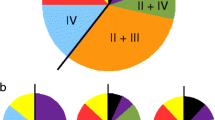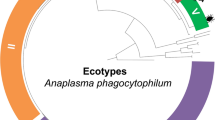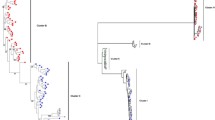Abstract
Anaplasma phagocytophilum is an obligate intracellular bacterial parasite in human and animal granulocytes. In Europe, A. phagocytophilum is transmitted by Ixodes ticks; Ixodes ricinus is the vector of the parasite in Poland. In terms of epidemiology, the identification of pathogens in ticks increasingly relies on molecular techniques. Polymerase chain reaction (PCR) with species-specific primers is a tool that allows the quick and accurate detection of pathogens in ticks, humans, or animals. DNA was extracted from the blood of Capreolus capreolus and Cervus elaphus, and amplified using the primers HS1/HS6 (external) and HS43/HSVR (internal). For sequencing, six samples from roe deer and two samples from red deer were selected, and the resulting sequences were submitted to GenBank (accession numbers DQ779568, DQ779567, EU157919, EU157920, EU157921, EU157922). These nucleotide sequences were compared with each other and five variants were distinguished in roe deer and one in red deer. A comparison of the sequences of the author’s database revealed 45 polymorphic sites of substitution character (76% transitions and 24% transversions). The homology tree revealed two groups, one with sequences only from roe deer, while the second with sequences isolated mainly from red deer, livestock animals, and humans. These strains of A. phagocytophilum are also present in Poland.

Similar content being viewed by others
References
Dumler JS, Barbet AF, Bekker CP, Dasch GA, Palmer GH, Ray SC, Rikihisia Y, Rutangirwa FR (2001) Reorganization of genera in the families Rickettsiaceae and Anaplasmataceae in the order Rickettsiales: unification of some species of Ehrlichia with Anaplasma, Cowdria with Ehrlichia and Ehrlichia with Neorickettsia, descriptions of six new species combinations and designation of Ehrlichia equi and ‘HGE agent’ as subjective synonyms of Ehrlichia phagocytophila. Int J Syst Evol Microbiol 51:2145–2165
Petrovec M, Lotric Furlan S, Zupanc TA, Strle F, Brouqui P, Roux V, Dumler JS (1997) Human disease in Europe caused by a granulocytic Ehrlichia species. J Clin Microbiol 35:1556–1559
Tylewska-Wierzbanowska S, Chmielewski T, Kondrusik M, Hermanowska-Szpakowicz T, Sawicki W, Sułek K (2001) First cases of acute human granulocytic ehrlichiosis in Poland. Eur J Clin Microbiol Infect Dis 20:196–198
Chen SM, Dumler JS, Bakken JS, Walker DH (1994) Identification of a granulocytotropic Ehrlichia species as the etiologic agent of human disease. J Clin Microbiol 32:589–595
Sumner JW, Nicholson WL, Massung RF (1997) PCR amplification and comparison of nucleotide sequences from the groESL heat shock operon of Ehrlichia species. J Clin Microbiol 35:2087–2092
Petrovec M, Bidovec A, Sumner JW, Nicholson WL, Childs JE, Avsic-Zupanc T (2002) Infection with Anaplasma phagocytophila in cervids from Slovenia: evidence of two genotypic lineages. Wien Klin Wochenschr 114:641–647
Stuen S, Bergström K, Petrovec M, Van de Pol I, Schouls LM (2003) Differences in clinical manifestations and hematological and serological responses after experimental infection with genetic variants of Anaplasma phagocytophilum in sheep. Clin Diagn Lab Immunol 10:692–695
Chae JS, Foley JE, Dumler JS, Madigan JE (2000) Comparison of the nucleotide sequences of 16S rRNA, 444 Ep-ank, and groESL heat shock operon genes in naturally occurring Ehrlichia equi and human granulocytic ehrlichiosis agent isolates from Northern California. J Clin Microbiol 38:1364–1369
Petrovec M, Sumner JW, Nicholson WL, Childs JE, Strle F, Barlic J, Lotric-Furlan S, Avsic-Zupanc T (1999) Identity of ehrlichial DNA sequences derived from Ixodes ricinus ticks with those obtained from patients with human granulocytic ehrlichiosis in Slovenia. J Clin Microbiol 37:209–210
Kimura M (1980) A simple method for estimating evolutionary rates of base substitutions through comparative studies of nucleotide sequences. J Mol Evol 16:111–120
Alberdi MP, Walker AR, Urquhart KA (2000) Field evidence that roe deer (Capreolus capreolus) are a natural host for Ehrlichia phagocytophila. Epidemiol Infect 124:315–323
Liz JS, Sumner JW, Pfister K, Brossard M (2002) PCR detection and serological evidence of granulocytic ehrlichial infection in roe deer (Capreolus capreolus) and chamois (Rupicapra rupicapra). J Clin Microbiol 40:892–897
Rymaszewska A, Skotarczak B (2005) Identification of Anaplasma phagocytophilum in Ixodes ricinus ticks in West Pomerania, Poland. Multidiscipilnarily for Parasites, Vectors and Parasitic Diseases, Monduzi Editore International Proceedings Division, Bologna, Italy, pp 309–314
Skotarczak B, Rymaszewska A, Wodecka B, Sawczuk M (2003) Molecular evidence of coinfection of Borrelia burgdorferi sensu lato, human granulocytic ehrlichiosis agent, and Babesia microti in ticks from northwestern Poland. J Parasitol 89:194–196
Adamska M (2006) Detecting Anaplasma phagocytophilum DNA in blood of roe deer and in ticks. Med Wet 62:201–203
Author information
Authors and Affiliations
Corresponding author
Rights and permissions
About this article
Cite this article
Rymaszewska, A. Divergence within the marker region of the groESL operon in Anaplasma phagocytophilum . Eur J Clin Microbiol Infect Dis 27, 1025–1036 (2008). https://doi.org/10.1007/s10096-008-0539-x
Received:
Accepted:
Published:
Issue Date:
DOI: https://doi.org/10.1007/s10096-008-0539-x




